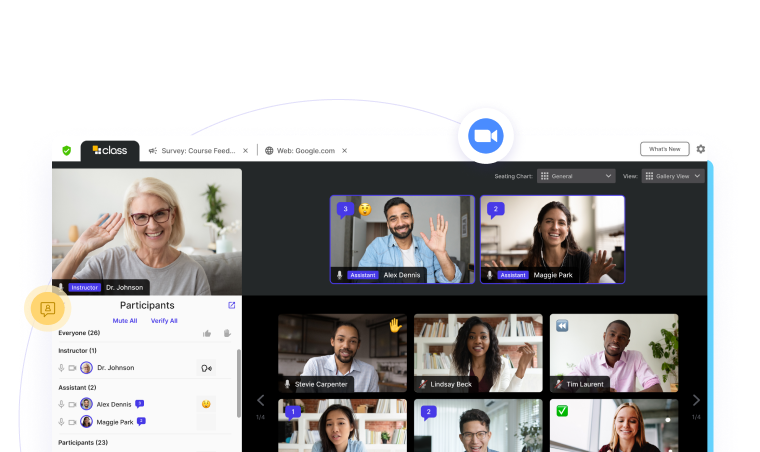
Gerald Glynn is a seasoned enterprise sales professional with 20+ years in software, including Adobe Connect, Zoom, and now Class. Known for his consultative approach, he helps organizations adopt web conferencing, webinars, virtual classroom, and collaboration tools that drive engaging and impactful virtual experiences.

Gerald Glynn is a seasoned enterprise sales professional with 20+ years in software, including Adobe Connect, Zoom, and now Class. Known for his consultative approach, he helps organizations adopt web conferencing, webinars, virtual classroom, and collaboration tools that drive engaging and impactful virtual experiences.

You admit 40 participants from the waiting room. Someone pings: “no sound.” A DM pops up: Where’s today’s case study file? You start screen sharing: slides on one side, notes on the other, and your own video in a row of faces (or just names on black screens). Posture check. The chat counter climbs. A trainee mouths words you can’t hear. It’s been 90 seconds, and you're already juggling windows, tabs, clicks, chats, and decisions.
This is a typical start for many virtual instructors. What begins as mild fatigue can quickly snowball into cognitive overload, especially when the tech isn't built for live instruction.
Teaching will always require mental effort, as it should. Guiding others through new ideas, skills, and ways of thinking is inherently demanding: stretching minds, opening perspectives, and helping learners expand their horizons. But if we can remove the avoidable friction—the scattered tools, toggles, and tasks that sap attention—then instructors regain the bandwidth to focus on what matters most: teaching.
Cognitive Load Theory tells us that our working memory can only handle so much at once. In typical learning settings, instructors often face three types of mental demand in every session:
In virtual instructor-led training, traditional video conferencing tools often increase extraneous load, pulling instructors into task-switching and troubleshooting instead of instruction.
Slides on one screen. Chat and gallery view on another. Notes on a tablet. Resources queued up to share in another tab. Instructors spend sessions scanning, switching, and searching, trying to stay present with learners while queuing up what’s next. This is the split-attention effect. When related information is spread out, the brain works harder to integrate it. The constant visual juggling eats up energy that could be better spent on interaction with learners.
In a typical video grid, instructors are surrounded by faces, including their own. Monitoring body language, gauging engagement, and self-checking expressions, postures, and backgrounds takes a toll. Stanford research on “Zoom fatigue” found that persistent self-view, close-up eye contact, and limited movement increase cognitive strain.
Launching polls, answering chat, adjusting breakouts, and sharing screens often happen all at once, creating a constant cycle of multitasking that quickly leads to cognitive fatigue. Research shows that juggling tasks in virtual settings reduces performance and increases stress. When instructors are stretched too thin, focus shifts away from learners and instruction quality suffers.
When microphones are muted, reactions delayed, and cameras off, instructors are left searching for invisible cues to gauge presence and understanding, a task that quickly adds to their cognitive load. In a physical classroom, glances, nods, or body language offer instant feedback. Online, those signals are muted or missing, forcing instructors to work harder just to know if learners are following along.
Not every learner absorbs information the same way. Some rely on visuals to see concepts in action, others prefer clear verbal explanations, and many benefit from exploring content hands-on. In a live virtual class, these differences often surface all at once. Instructors must adjust pacing, format, and delivery on the fly—a constant adaptation that adds to cognitive load.
The mental demands of virtual training are real, but not unchangeable. These small, tactical tips can help reduce extraneous load during live virtual instruction:
Even small changes like these can give instructors more space to teach with clarity and focus.
Instructors don’t burn out because they lack subject knowledge. They burn out because their attention is pulled in a dozen directions. Every toggle, tech hiccup, and unclear learner response drains energy from teaching.
Class doesn’t eliminate cognitive load entirely, but it does dramatically reduce the kind that doesn’t belong. With workflows and tools built to reduce friction in facilitation, Class helps instructors get back to doing what they do best: engaging learners, guiding discovery, and making complex ideas click.
When your platform is built for teaching, not just meetings, you create space for better instruction, stronger engagement, and more confident instructors. Lightening the load improves both the teaching experience and learning outcomes. Connect with our team to see how Class can help you make both possible.

Gerald Glynn is a seasoned enterprise sales professional with 20+ years in software, including Adobe Connect, Zoom, and now Class. Known for his consultative approach, he helps organizations adopt web conferencing, webinars, virtual classroom, and collaboration tools that drive engaging and impactful virtual experiences.

Gerald Glynn is a seasoned enterprise sales professional with 20+ years in software, including Adobe Connect, Zoom, and now Class. Known for his consultative approach, he helps organizations adopt web conferencing, webinars, virtual classroom, and collaboration tools that drive engaging and impactful virtual experiences.
Get our insights, tips, and best practices delivered to your inbox

Sign up for a product demo today to learn how Class’s virtual classroom powers digital transformation at your organization.

Features
Products
Integrations